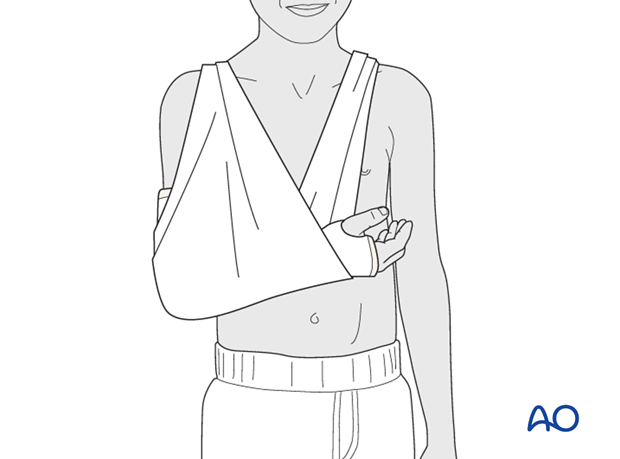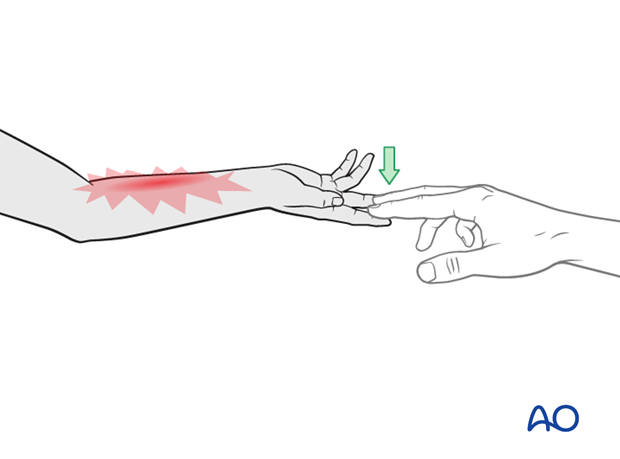Open reduction; plate fixation
1. General considerations
Plating is the standard technique for treating forearm fractures in adults and is therefore best considered for skeletally mature or nearly mature children.
Children with open physes have thick active periosteum favoring stability and rapid healing with the ESIN method. Where such techniques are unavailable plating may be used in younger children.
In Monteggia lesions two points are crucial for successful reduction of the radial head:
- Restoration of ulnar length
- Stable reduction of the radiocapitellar joint
An anatomical reduction of the ulna may not be sufficient to anatomically reduce and stabilize the radiocapitellar joint. An overcorrection of the ulna may be necessary, and this can make plating technically difficult.

2. Principles
Order of reduction and fixation
The usual strategy to deal with a Monteggia lesion is:
- Stable anatomical reduction or overcorrection of the ulna
- Assess the radial head position and stability using image intensification.
- If necessary, revise the position of the ulna.
- If necessary, perform an open reduction of the radial head.
Choice of approach
The ulna is exposed by the direct approach between the flexor and extensor muscle compartments.
If the radiocapitellar relationship is not perfect and stable, then the radiocapitellar joint can be explored.
A lateral (Kocher) approach to the elbow is usually performed.
An alternative is the posterolateral approach, which provides access to both the proximal ulna and the radial head. A disadvantage of this approach is the potential for cross-union.
3. Patient preparation
This procedure is normally performed with the patient in a supine position.

4. Reduction and fixation of the ulnar fracture
Reduction of the ulna
The alignment of the ulna is addressed first.
The ulna needs to be fully out to length and stable. If this is not achieved the radial head can redislocate or sublux leading to permanent loss of forearm function.
Fixation of the ulna
Plating of pediatric forearm shaft fractures follows the technique for plate fixation in adults.
The steps for ulnar fracture fixation are described in the relevant plating procedure for each fracture type:

Prebending the plate for a Monteggia lesion
Overcorrecting the ulna can be necessary to improve the stability of the radiocapitellar joint.
The ulnar shaft will hold the radius reduced through the interosseous membrane.
In children with Monteggia lesions and proximal ulnar shaft fractures, a plate can be contoured to produce an overcorrected position.
This may result in greater stability of the radiocapitellar joint than anatomically reducing the ulna.

Ulnar osteotomy for plastic deformity
A Monteggia lesion with plastic deformity of the ulna has a strong tendency for the radial head to redislocate as the ulna rebounds to the original position.

An osteotomy of the proximal ulnar shaft with overreduction can be held with an appropriately contoured plate.
In the illustrated example an apex dorsal angulation of the ulna prevents anterior redislocation of the radial head.

5. Assessing the radial head position
Reduction of radial head
The radial head will usually reduce closed and remain stable once the ulna has been aligned.
Rotational movements of the forearm may be necessary to complete the reduction of the radial head.
After fixation of the ulna, use an image intensifier to carefully evaluate the position of the radial head relative to the capitellum.
This must be confirmed through a full range of flexion, extension, pronation and supination.

Revision of ulnar reduction and fixation
At this stage the ulnar reduction can be revised if required, often to an overcorrected position, which usually results in stable anatomical reduction of the radial head.

If there is residual subluxation or instability in any position after optimization of the ulnar correction, there may be interposed tissue (usually annular ligament) in the radiocapitellar joint and an open reduction of this joint should be performed.
6. Open reduction of radial head
Approach to radial head
Perform a lateral approach and manually reduce the radial head.

Removal of blocks to reduction
The annular ligament is the most common intraarticular block to reduction. In rare cases the ligament can be gently repositioned around the radial head.
More often the ligament must be incised or excised to allow reduction of the radial head.

Reassessment of radial head position
Reassess the position and stability of the radial head by direct visual inspection and image intensification.
7. Final assessment
Check the completed osteosynthesis with image intensification. These images should be retained for documentation or alternatively an x-ray should be obtained before discharge.
Make sure that the plate is at the correct location, the screws are of appropriate length, the desired reduction has been achieved and the radial head remains in the appropriate position.

Stabilize the elbow at the epicondyles and check the forearm rotation.

8. Aftercare following plating
Immediate postoperative care
Whilst the child remains in bed, the forearm should be elevated on pillows to reduce swelling and pain.

Casting or Splinting
Plate fixation of forearm fractures is intrinsically stable and supplementary casting or splinting is therefore not required.
Some surgeons prefer a long or short splint for 2-3 weeks postoperatively for comfort.
For Monteggia lesions treated with ulnar plating, the forearm may be immobilized in a cast in the position of maximum stability of the radial head for 2-4 weeks.

Analgesia
Ibuprofen and paracetamol should be administered regularly during the first 4-5 days of injury, with additional oral narcotic medication for breakthrough pain.
If the level of pain is increasing the child should be examined.
Neurovascular examination
The child should be examined regularly, to ensure finger range of motion is comfortable and adequate.
Neurological and vascular examination should also be performed.
Compartment syndrome should be considered in the presence of increasing pain, especially pain on passive stretching of muscles, decreasing range of active finger motion or deteriorating neurovascular signs, which are a late phenomenon.
See also the additional material on postoperative infection.

Compartment syndrome
Compartment syndrome is a possible early postoperative complication that may be difficult to diagnose in younger children.
The presence of full passive or active finger extension, without discomfort, excludes muscle compartment ischemia.
If there are signs of a compartment syndrome:
- If the child is in a cast, split the cast, along its full length down to skin level.
- Elevate the limb.
- Encourage active finger movement.
- Reexamine the child after 30 min.
If a definitive diagnosis of compartment syndrome is made, then a fasciotomy should be performed without delay.

Discharge care
Discharge from hospital follows local practice and is usually possible after 1-3 days.
The parent/carer should be taught how to assess the limb.
They should also be advised to return if there is increased pain or decreased range of finger movement.
It is important to provide parents with the following additional information:
- The warning signs of compartment syndrome, circulatory problems and neurological deterioration
- Hospital telephone number
- Information brochure
For the first few days, the elbow and forearm can be elevated on a pillow, until swelling decreases and comfort returns.
The arm can be placed in a sling for a few days until the patient is pain free. Many children are more comfortable without support.
Mobilization
Early movement of the forearm should be encouraged as soon as the patient is pain free.
Formal physiotherapy is normally not indicated, but children should have a sheet of exercises to stimulate mobilization.
Follow-up
The first clinical and radiological follow-up depends on the age of the child and is usually undertaken 4 weeks postoperatively.
At this point, the child should be able to move the forearm almost fully.
AP and lateral x-rays are required.
See also the additional material on healing times.
Plate removal
Plate removal is delayed for at least 6 months.
An asymptomatic plate that does not interfere with forearm rotation can be left in place minimizing complications associated with implant removal.












